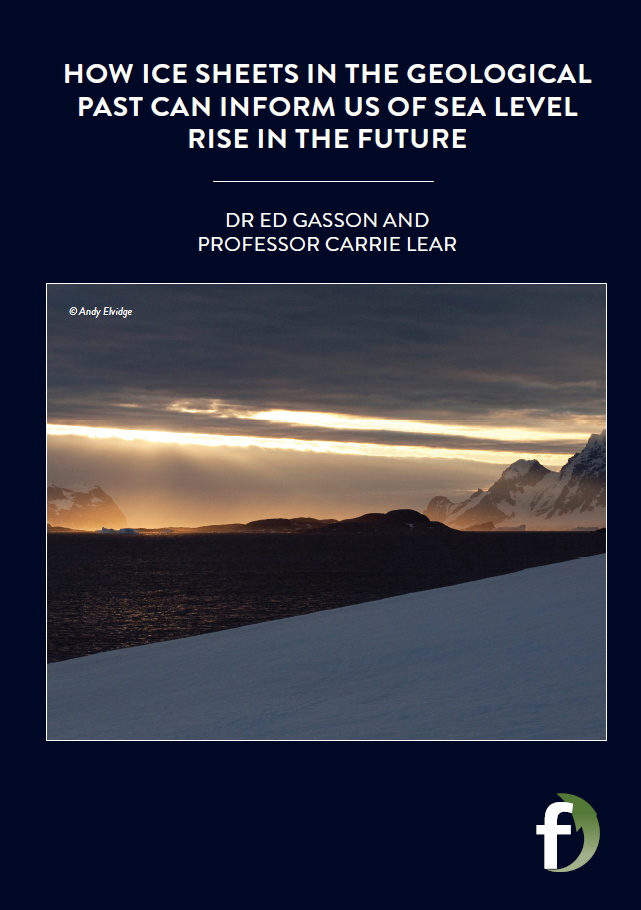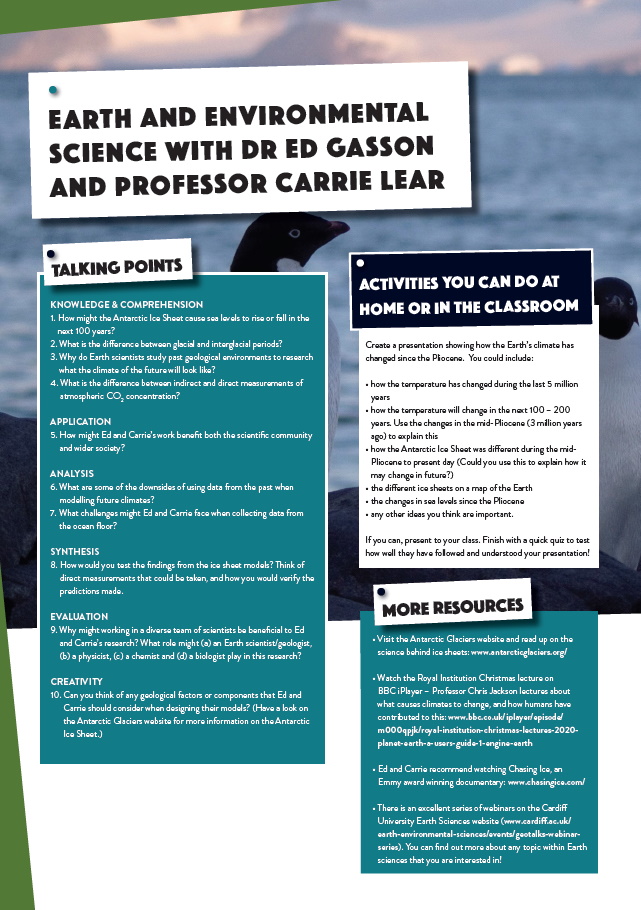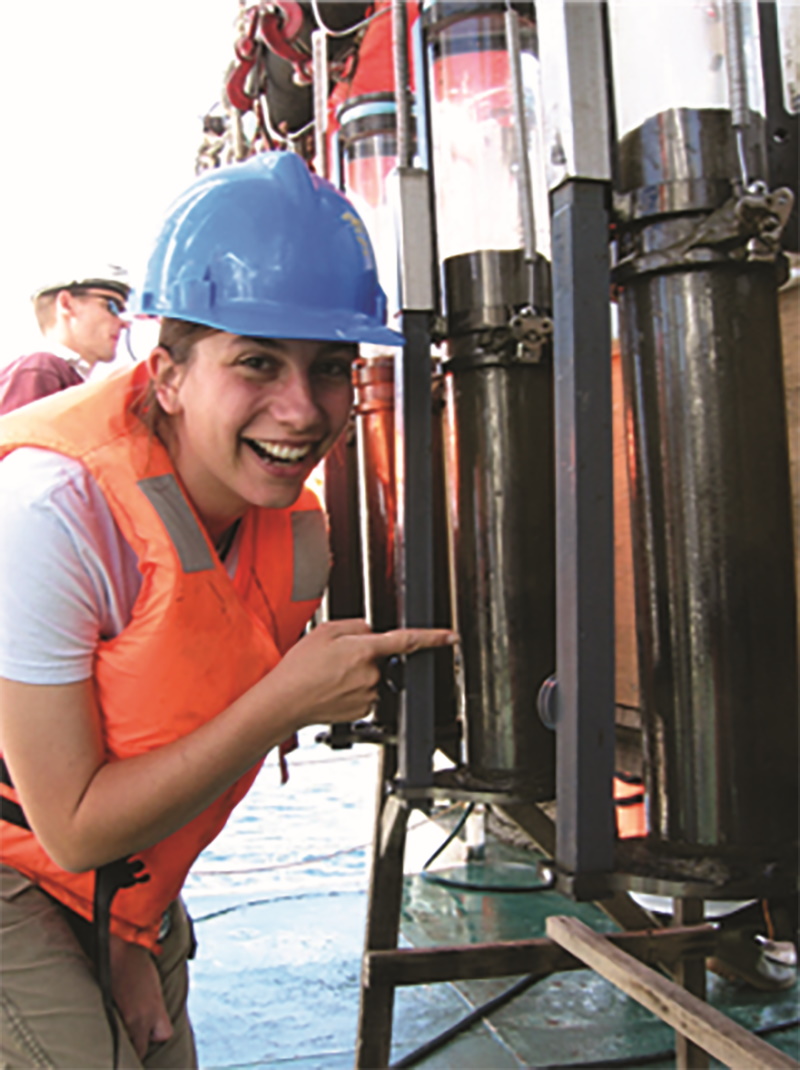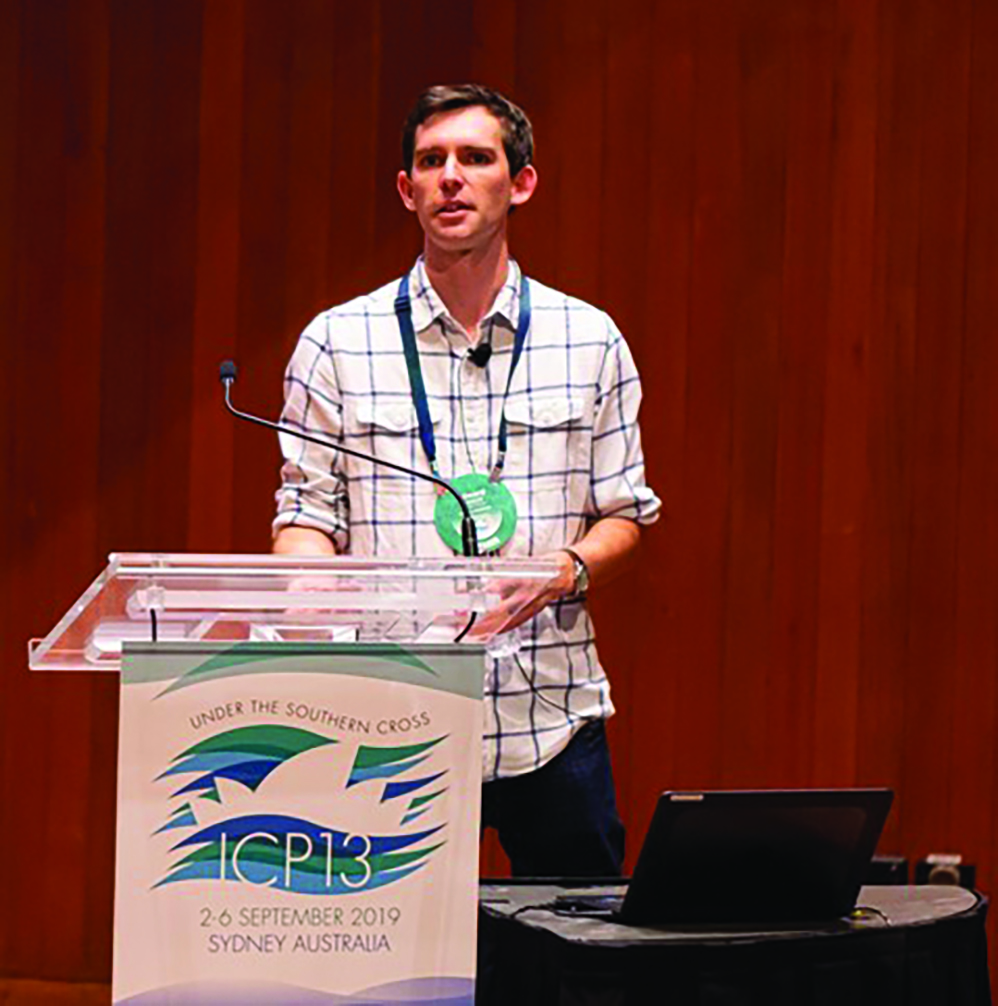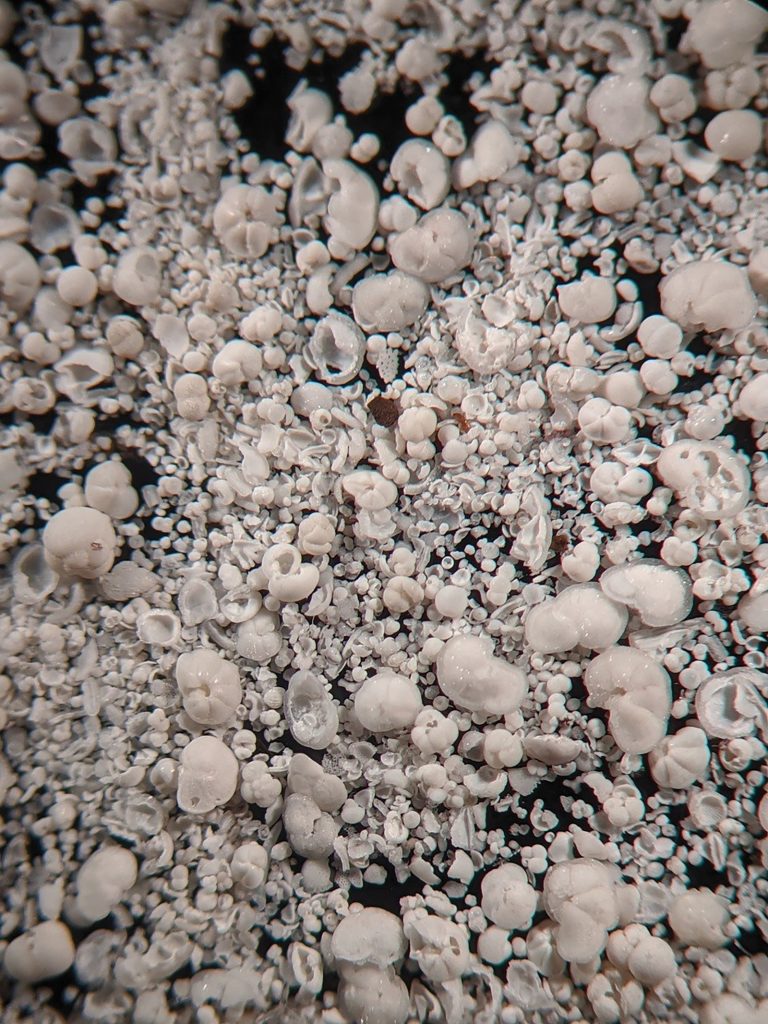How ice sheets in the geological past can inform us of sea level rise in the future
The future of the earth’s sea levels due to climate change is incredibly difficult to predict. Dr Ed Gasson, at the University of Exeter, and Professor Carrie Lear, at Cardiff University, in the UK, are Earth and environmental scientists researching how the Antarctic ice sheet changed during the Earth’s past, in order to predict how it will influence future changes to sea levels
TALK LIKE AN EARTH AND ENVIRONMENTAL SCIENTIST
ANTARCTIC ICE SHEET – the large mass of ice that covers the South Pole and 98% of the Antarctic continent
CLIMATE MODELS – mathematical representations of the Earth’s atmosphere and oceans
GLACIAL – an interval of time within an ice age where colder temperatures persist and glaciers advance
INTERGLACIAL – the warmer period of time between ice ages where temperatures rise and glaciers retreat. We have been in an interglacial stage for about 10,000 years
ISOTOPE GEOCHEMISTRY – an area of geology that looks at the relative abundance of different isotopes (such as in the microfossils that Ed and Carrie analyse)
PALAEOCLIMATE – the study of how and why our planet’s climate has changed through its history
PLIOCENE – a geological epoch covering the geological timescale between 5.3 and 2.6 million years ago
PROXIES – indirect methods for determining past environmental parameters, such as the temperature of the Earth and the past CO2 concentration of the atmosphere, using materials preserved within the geological record
SEA LEVEL – commonly meaning the average surface level of the oceans across Earth, affected by many processes on different timescales
The melting of the Antarctic Ice Sheet and subsequent changes to sea levels could have profound impacts on communities all round the world. A billion people live on land less than 10 metres above current high tides and are particularly vulnerable to the impacts of sea level rise. Loss of land, increased flood risk and disruption to key infrastructure, like power stations, are particular dangers people may face.
Scientists’ current projections of how sea levels will change in 2100 and beyond vary significantly. Sea levels could fall slightly due to ice sheet growth from increased snowfall as the Antarctic warms. They could also rise up to 1.4 metres as the ice sheet melts. To improve current projections of sea level rise, Dr Ed Gasson at the University of Exeter and Professor Carrie Lear of Cardiff University are simulating glacial and interglacial conditions in the Earth’s past. Modelling changes to the Antarctic Ice Sheet in these times, they hope to understand the extent of sea level change in the future.
RECONTRUCTING THE ENVIRONMENT OF THE PAST
Precise predictions of future climates are hard to achieve as changes to the climate will depend largely on whether we take firm action to reduce greenhouse gas emissions now. However, Earth scientists can look into the geological past to find out what past climates were like, and how the ice sheets changed during these periods. The Earth’s climate has varied from Ice Ages with mile-thick ice covering much of the land in the northern hemisphere to periods warmer than today. The last time the atmospheric CO2 conditions were as high as today was around 3 million years ago in the mid-Pliocene.
To reconstruct past climates, scientists can measure atmospheric CO2 from gas bubbles trapped in ice cores. These only provide measurements for the past 800,000 years; to go further into the geological past, a range of indirect techniques, called proxies, are used. If these match the changes measured in the ice cores, scientists can be confident that the proxies are reproducing atmospheric CO2 levels further back in time.
The warming during the mid-Pliocene was a long-term ‘equilibrium’ response, rather than the current sharp increase in CO2. “The rate of CO2 increase is much faster now than in the past, and we will even exceed the CO2 concentrations in the mid-Pliocene by 2025,” says Ed.
SIMULATING ICE SHEETS IN THE PLIOCENE
Ed and Carrie can calculate ice sheet volume by analysing trace metals and the isotopic composition of microfossils within sediments. This tells them how warm the oceans were in the past and how much CO2 was dissolved in them. They also use oxygen isotope ratios of fossil plankton which tells them how salty the oceans were. “As the ice sheets grew, more freshwater was stored on land, making the oceans slightly saltier. As the ice sheets melted, that freshwater was put back into the oceans, making them slightly fresher,” explains Carrie.
“Although our geochemical records cannot tell us where the ice sheets were, we can work out how large they were, and how quickly they grew and melted,” explains Carrie. The team simulates how big the ice sheet got during the cooler ‘glacial’ stages of the mid-Pliocene, and how small it got during the warmer ‘interglacial’ stages. “To do this, we have to take into account all of the differences that drove the transition from a cool to a warmer climate,” says Ed.
TESTING THE MODELS
“We’ve been trying for a long time to simulate Antarctic Ice Sheet melt during past warm intervals, and we’ve often failed,” says Ed. The problem is that ice sheet changes inferred from paleoclimate data are larger than Ed and Carrie can simulate using their models. “Due to the uncertainty of proxy data, it can be difficult to determine whether a model is successful at simulating the past or not,” explains Ed. This could result in a underprediction of sea level changes, making predictions for the future misleading.
“If we reduce the paleoclimate data ranges, we can make a more stringent test for the models. Our future sea level predictions can then be made with more confidence,” explains Ed. Currently, team member Amy Thomas-Sparkes has prepared hundreds of fossils for analysis and knows the exact ages of these fossils. “This will be really important as it will help us work out how fast the Antarctic Ice Sheet grew and decayed in the past,” says Carrie.
LOOKING TO THE FUTURE
The new sea level records from these fossils will help Ed and Carrie test and calibrate their own ice sheet models. Currently, these models predict faster rates of sea level rise in the future, but there are still modelling issues that need to be addressed. Models must pass the test of matching previous Pliocene sea level estimates. “Because the range of Pliocene sea level estimates are so large, many different models pass this test,” explains Ed. This causes a big range in future sea level projections. “We’re hoping to narrow the number of models that pass the test, then we can also narrow the range in our future projections,” he explains.
The team can do this by adding more and more components of the Earth system to their models, enabling Ed and Carrie to understand how these components interact. “However, this adds to the complexity and makes our models slower to run,” says Ed. “It’s a fine line between making the models complex, while keeping them usable.”
This work focuses on indirectly measuring the retreat of ice sheets and does not indicate which parts of the ice sheet are melting. For this, direct geological records need to be accessed by drilling sediment cores around Antarctica. “We’re involved with an upcoming Antarctic drilling campaign that can hopefully resolve some really big outstanding questions in Antarctic science,” says Ed.
 DR ED GASSON
DR ED GASSON
Royal Society University Research
Fellow, University of Exeter, UK
FUNDERS: Natural Environment Research Council, National Science Foundation (USA), The Royal Society
PROFESSOR CARRIE LEAR
Cardiff University, UK
FUNDERS: Natural Environment Research Council, European Commission
FIELD OF RESEARCH: Earth and Environmental Science
JOINT RESEARCH PROJECT: Using paleoclimate data from the mid-Pliocene to test and calibrate Antarctic Ice Sheet models in order to estimate the rise in future sea levels
ABOUT EARTH AND ENVIRONMENTAL SCIENCE
This is an extremely broad field. “In order to understand everything about the Earth system, or even just the climate system, you would have to be an expert in physics, chemistry, maths, biology, and Earth sciences!” says Carrie. She finds it very rewarding to work in a diverse team with everyone playing to their strengths, which is essential for making new discoveries. Many of these scientific questions have societal relevance, so it is a very rewarding area to work in.
Ed is finding ways to stay optimistic even though there is a long way to go to reach net zero emissions. He highlights the price of renewables falling year on year, alongside the phasing out of coal in the UK, as big positives. “The UK needs to go further. As the first nation to industrialise, the UK has an obligation to lead the response to climate change,” he says. “For example, the UK recently hosted the United Nations Climate Change Conference (COP26) in Glasgow.”
Reference
https://doi.org/10.33424/FUTURUM241
ANTARCTIC ICE SHEET – the large mass of ice that covers the South Pole and 98% of the Antarctic continent
CLIMATE MODELS – mathematical representations of the Earth’s atmosphere and oceans
GLACIAL – an interval of time within an ice age where colder temperatures persist and glaciers advance
INTERGLACIAL – the warmer period of time between ice ages where temperatures rise and glaciers retreat. We have been in an interglacial stage for about 10,000 years
ISOTOPE GEOCHEMISTRY – an area of geology that looks at the relative abundance of different isotopes (such as in the microfossils that Ed and Carrie analyse)
PALAEOCLIMATE – the study of how and why our planet’s climate has changed through its history
PLIOCENE – a geological epoch covering the geological timescale between 5.3 and 2.6 million years ago
PROXIES – indirect methods for determining past environmental parameters, such as the temperature of the Earth and the past CO2 concentration of the atmosphere, using materials preserved within the geological record
SEA LEVEL – commonly meaning the average surface level of the oceans across Earth, affected by many processes on different timescales
The melting of the Antarctic Ice Sheet and subsequent changes to sea levels could have profound impacts on communities all round the world. A billion people live on land less than 10 metres above current high tides and are particularly vulnerable to the impacts of sea level rise. Loss of land, increased flood risk and disruption to key infrastructure, like power stations, are particular dangers people may face.
Scientists’ current projections of how sea levels will change in 2100 and beyond vary significantly. Sea levels could fall slightly due to ice sheet growth from increased snowfall as the Antarctic warms. They could also rise up to 1.4 metres as the ice sheet melts. To improve current projections of sea level rise, Dr Ed Gasson at the University of Exeter and Professor Carrie Lear of Cardiff University are simulating glacial and interglacial conditions in the Earth’s past. Modelling changes to the Antarctic Ice Sheet in these times, they hope to understand the extent of sea level change in the future.
RECONTRUCTING THE ENVIRONMENT OF THE PAST
Precise predictions of future climates are hard to achieve as changes to the climate will depend largely on whether we take firm action to reduce greenhouse gas emissions now. However, Earth scientists can look into the geological past to find out what past climates were like, and how the ice sheets changed during these periods. The Earth’s climate has varied from Ice Ages with mile-thick ice covering much of the land in the northern hemisphere to periods warmer than today. The last time the atmospheric CO2 conditions were as high as today was around 3 million years ago in the mid-Pliocene.
To reconstruct past climates, scientists can measure atmospheric CO2 from gas bubbles trapped in ice cores. These only provide measurements for the past 800,000 years; to go further into the geological past, a range of indirect techniques, called proxies, are used. If these match the changes measured in the ice cores, scientists can be confident that the proxies are reproducing atmospheric CO2 levels further back in time.
The warming during the mid-Pliocene was a long-term ‘equilibrium’ response, rather than the current sharp increase in CO2. “The rate of CO2 increase is much faster now than in the past, and we will even exceed the CO2 concentrations in the mid-Pliocene by 2025,” says Ed.
SIMULATING ICE SHEETS IN THE PLIOCENE
Ed and Carrie can calculate ice sheet volume by analysing trace metals and the isotopic composition of microfossils within sediments. This tells them how warm the oceans were in the past and how much CO2 was dissolved in them. They also use oxygen isotope ratios of fossil plankton which tells them how salty the oceans were. “As the ice sheets grew, more freshwater was stored on land, making the oceans slightly saltier. As the ice sheets melted, that freshwater was put back into the oceans, making them slightly fresher,” explains Carrie.
“Although our geochemical records cannot tell us where the ice sheets were, we can work out how large they were, and how quickly they grew and melted,” explains Carrie. The team simulates how big the ice sheet got during the cooler ‘glacial’ stages of the mid-Pliocene, and how small it got during the warmer ‘interglacial’ stages. “To do this, we have to take into account all of the differences that drove the transition from a cool to a warmer climate,” says Ed.
TESTING THE MODELS
“We’ve been trying for a long time to simulate Antarctic Ice Sheet melt during past warm intervals, and we’ve often failed,” says Ed. The problem is that ice sheet changes inferred from paleoclimate data are larger than Ed and Carrie can simulate using their models. “Due to the uncertainty of proxy data, it can be difficult to determine whether a model is successful at simulating the past or not,” explains Ed. This could result in a underprediction of sea level changes, making predictions for the future misleading.
“If we reduce the paleoclimate data ranges, we can make a more stringent test for the models. Our future sea level predictions can then be made with more confidence,” explains Ed. Currently, team member Amy Thomas-Sparkes has prepared hundreds of fossils for analysis and knows the exact ages of these fossils. “This will be really important as it will help us work out how fast the Antarctic Ice Sheet grew and decayed in the past,” says Carrie.
LOOKING TO THE FUTURE
The new sea level records from these fossils will help Ed and Carrie test and calibrate their own ice sheet models. Currently, these models predict faster rates of sea level rise in the future, but there are still modelling issues that need to be addressed. Models must pass the test of matching previous Pliocene sea level estimates. “Because the range of Pliocene sea level estimates are so large, many different models pass this test,” explains Ed. This causes a big range in future sea level projections. “We’re hoping to narrow the number of models that pass the test, then we can also narrow the range in our future projections,” he explains.
The team can do this by adding more and more components of the Earth system to their models, enabling Ed and Carrie to understand how these components interact. “However, this adds to the complexity and makes our models slower to run,” says Ed. “It’s a fine line between making the models complex, while keeping them usable.”
This work focuses on indirectly measuring the retreat of ice sheets and does not indicate which parts of the ice sheet are melting. For this, direct geological records need to be accessed by drilling sediment cores around Antarctica. “We’re involved with an upcoming Antarctic drilling campaign that can hopefully resolve some really big outstanding questions in Antarctic science,” says Ed.
 DR ED GASSON
DR ED GASSON
Royal Society University Research
Fellow, University of Exeter, UK
FUNDERS: Natural Environment Research Council, National Science Foundation (USA), The Royal Society
PROFESSOR CARRIE LEAR
Cardiff University, UK
FUNDERS: Natural Environment Research Council, European Commission
FIELD OF RESEARCH: Earth and Environmental Science
JOINT RESEARCH PROJECT: Using paleoclimate data from the mid-Pliocene to test and calibrate Antarctic Ice Sheet models in order to estimate the rise in future sea levels
ABOUT EARTH AND ENVIRONMENTAL SCIENCE
This is an extremely broad field. “In order to understand everything about the Earth system, or even just the climate system, you would have to be an expert in physics, chemistry, maths, biology, and Earth sciences!” says Carrie. She finds it very rewarding to work in a diverse team with everyone playing to their strengths, which is essential for making new discoveries. Many of these scientific questions have societal relevance, so it is a very rewarding area to work in.
Ed is finding ways to stay optimistic even though there is a long way to go to reach net zero emissions. He highlights the price of renewables falling year on year, alongside the phasing out of coal in the UK, as big positives. “The UK needs to go further. As the first nation to industrialise, the UK has an obligation to lead the response to climate change,” he says. “For example, the UK recently hosted the United Nations Climate Change Conference (COP26) in Glasgow.”
“There are incredibly few people working on sea level rise,” says Ed. He would like to see many more people working on the issues facing our society. “When it’s going to affect hundreds of millions of people, it is fundamental that industries and policy makers support research and the people doing the research,” he explains.
EXPLORE A CAREER IN EARTH AND ENVIRONMENTAL SCIENCES
• Visit the Geological Society website for information on events and training resources.
• The Environment and Sustainability Institute at the University of Exeter runs an annual Earth and
Sustainability day and the university has a scheme for students to learn about university life and research called Exeter Scholars.
• Cardiff University is involved in several public outreach schemes. The School of Earth and Environmental Sciences hosts public events and has a YouTube channel.
• If you are interested in work experience at Cardiff University, you can email [email protected] explaining your interests and including your CV.
Any of the sciences, including geography, and maths would be great to study in school.
It is important to remember that a diverse skill set is valuable. If you are passionate about writing, do not feel like you need to drop a subject like English – it is important to be able to communicate the scientific discoveries you make.
At university, some Earth and environmental science courses will give you an offer if you have one science A-level. If you enjoy a range of sciences, you will find that many of them are used and integrated when studying at university.
HOW DID CARRIE BECOME AN EARTH SCIENTIST?
When I was younger, most of my interests involved being outdoors, whether this was fossil hunting or volunteering for local conversation projects. I’ve always loved learning about the world around me, so doing a degree in Earth sciences seemed a natural way to continue this.
I particularly like this childhood photo of me looking for fossil shark teeth and turtle shells. Although I didn’t really appreciate it at the time, I was finding evidence that when CO2 concentrations were higher in the past, the UK was much warmer than today!
Even though I always enjoyed science, I never really believed I could have a career in research. When I was a student, I didn’t meet any established female researchers in my field. Shortly after my PhD, I was lucky to be part of an ocean research expedition, helping to collect sediments from the seafloor. It was really exciting to bring ocean sediments up onto the deck and see evidence of past changes in climate. My eureka moment came on that expedition, after finishing a 12 hour shift with a female colleague and talking with a senior scientist about our future plans. Both of us commented that we didn’t feel like we belonged in the world of research, and I will never forget his surprise and dismay. He told us that scientific research would be better with people like us in it, and that really made a difference.
One of my proudest achievements was taking part in fieldwork where we found lots of new plankton fossils. Everyone on the team had a fossil named after them! My fossil is tiny, less than a millimetre in diameter.
The most important attribute to have while doing research is curiosity – wanting to answer puzzles that I see in the Earth’s climate system. After that I would say problem solving, collaboration and resilience for when things don’t go to plan, which happens very often in science. It’s important to focus on the big picture and not get put off by bumps in the road. That’s easier to do if you find supportive colleagues to work with.
For the future, if I could achieve one thing, it would be to help make academia a more inclusive environment – we have made progress, but we still have a long way to go.
HOW DID ED BECOME AN ENVIRONMENTAL SCIENTIST?
I have always been interested in the environment, and climate change is the biggest issue that we currently face. The way that climate change was (and sometimes still is) taught in school made me think that the science wasn’t settled yet. I wanted to be part of that so I could understand it for myself. However, there is no doubt about the fundamentals of climate change. There are still many areas that we do need to work on so we can make better projections for the future and, more importantly, come up with ways to manage and adapt to climate change.
One of the best aspects of being a scientist is that you drive your own research direction, so an interest and curiosity about what you’re working on is essential. However, you can’t do everything yourself, so being able to work with others who are experts in different areas is key. This is a great thing about being a scientist.
IN THE LAB

Dr Amy Thomas-Sparkes, Postdoctoral Research Associate at Cardiff University
The deep ocean sediments that we use for our work are retrieved by huge research vessels that drill into the sea floor all over the world’s oceans. When we get these ocean sediment samples to the lab, we carefully extract and clean the tiny fossils contained within. These tell us about the temperature and chemistry of the oceans, and the extent of ice sheets, throughout the history of our Earth. In particular, we work with fossilised microorganisms called foraminifera – tiny beings that have shells made of calcium carbonate. The composition of chemical elements in their shells can tell us what the oceans were like when they were alive.
We first separate foraminifera from the rest of the sediment by washing the sample though a small sieve that captures the fossilised shells. We then carefully pick out as many foraminifera of the same species as we can find. There are many species of foraminifera, each with a uniquely shaped shell. My favourite, and the one we are using in our current research project, is called Melonis barleeanum.
Once we have those foraminifera, we clean them to make sure the shell surfaces are not contaminated by other chemical elements. We do this in a clean lab wearing lab coats and goggles. We cannot contaminate our samples!
When the shells are clean, we dissolve them in ultra-clean acid and analyse this solution in a mass spectrometer. This machine tells us the amount of certain chemical elements contained in the foraminifera shell. For example, the amount of magnesium can tell us how warm the ocean was in the past!
THE TEAM’S TOP TIPS
01 Do something you love – work with supportive people who value your contributions and be supportive of others.
02 Don’t be afraid to be wrong or to say, “That’s an interesting question, but I don’t know what the answer is!” Being a scientist is all about asking questions, coming up with new ideas to answer those questions, and testing to see how accurate those new ideas may be.
Do you have a question for Ed, Carrie or Amy?
Write it in the comments box below and Ed, Carrie or Amy will get back to you. (Remember, researchers are very busy people, so you may have to wait a few days.)

